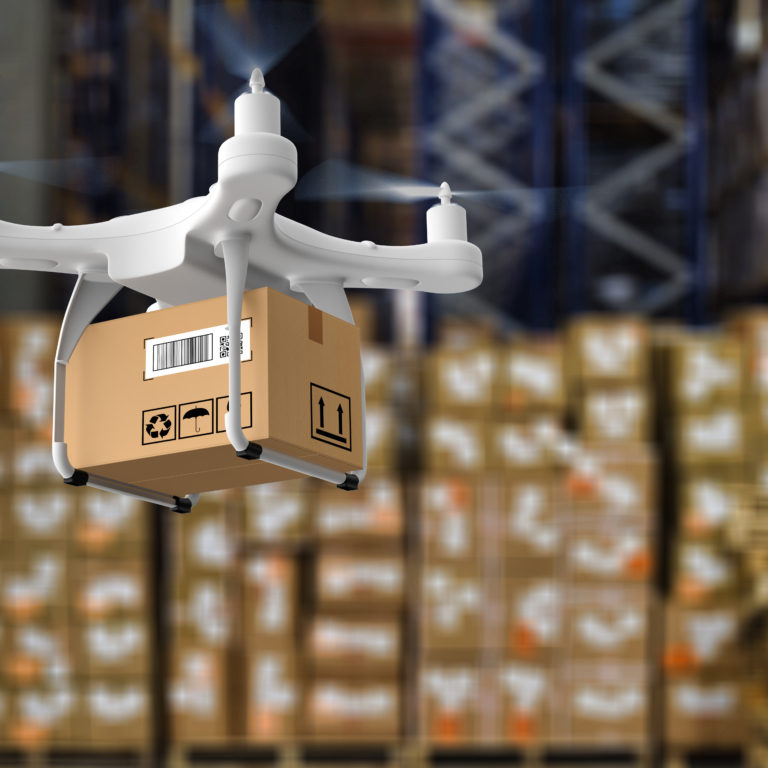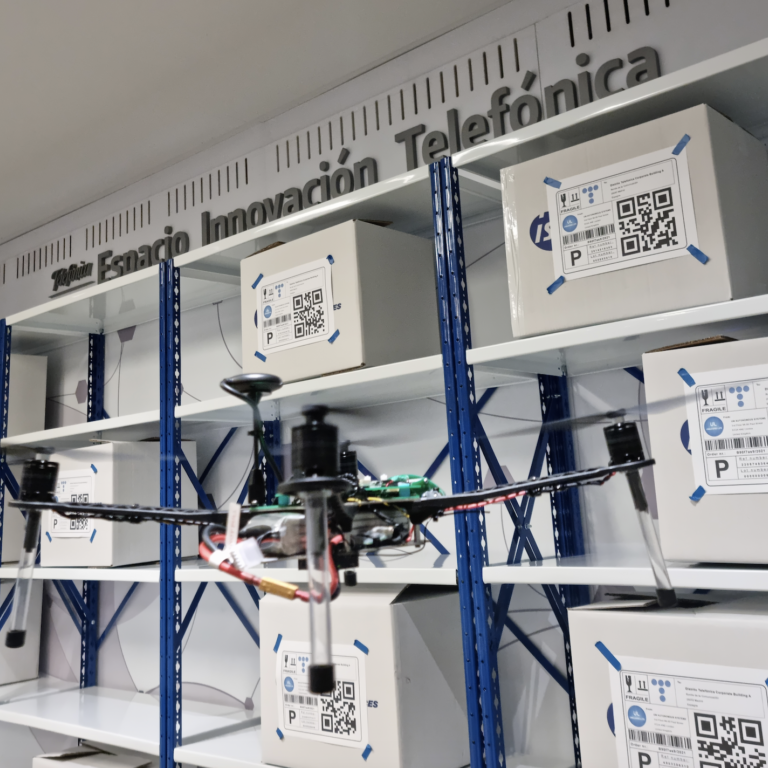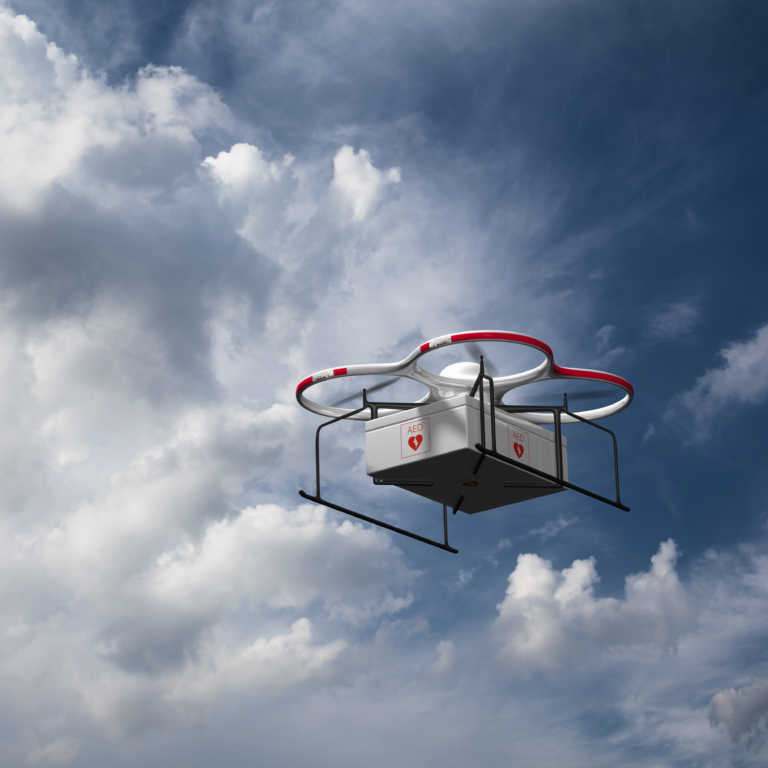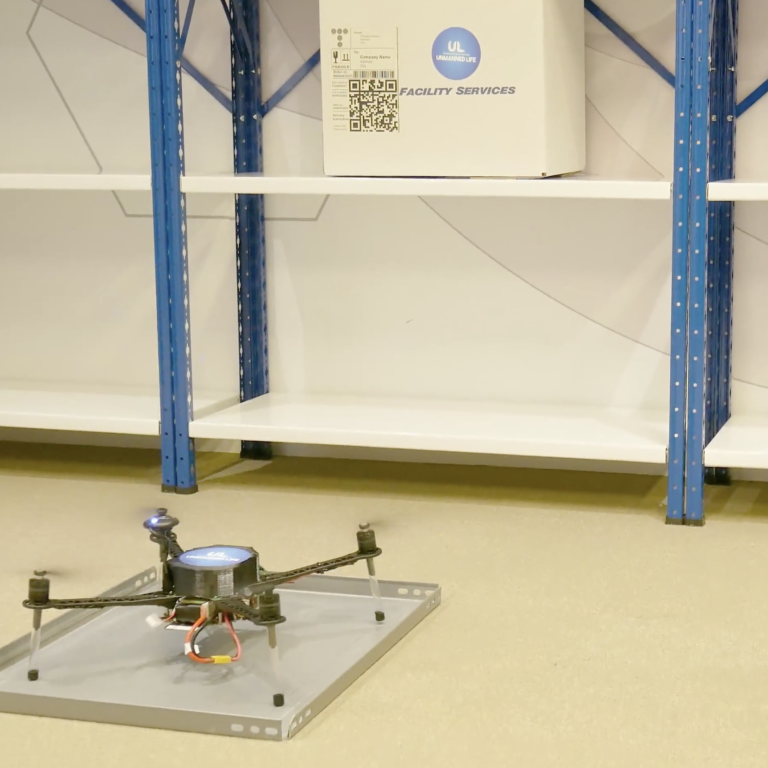5G Transformation Hub
How 5G can enable drones to perform key tasks
Supported by artificial intelligence, 5G-enabled drones could automate many repetitive or risky manual processes
Telefónica and tech partner Unmanned Life are trialling the use of 5G-connected drones to conduct automated stock takes at a demo centre in Madrid. The drones use low-latency 5G to stream video footage to an image recognition system running at the edge of the network.
Select a project
Contents
Challenge
Warehouses and depots have traditionally relied on staff to do manual stock checks that can involve climbing ladders and scanning the barcodes on boxes on racks. As well as being time-consuming, costly and sometimes dangerous, this process is error prone – people doing repetitive tasks can make mistakes, resulting in lost revenue.
Solution
Telefónica and Unmanned Life are trialling a solution that brings together lightweight drones, 5G connectivity, edge computing and artificial intelligence. Following a pre-planned route, the drones fly around the racks inside the warehouse or depot. As they do so, they use 5G to stream live video of the stock to an edge computing facility, which then uses image recognition software to update the inventory list in real-time. The drone also uses 5G to relay the precise location of each stock item. The highly responsive 5G network can also be used to quickly abort a mission in the event of a problem.
Impact & Statistics
The trial is demonstrating that 5G can deliver the necessary capacity and responsiveness to support video streaming from drones in a busy environment, according to Telefónica and Unmanned Life. They say the results to date suggest drones can provide cost-effective, scalable and traceable approaches to inventory management.
Wider Implications
The trial is showing that drones can operate effectively indoors if they are supported by 5G connectivity and edge infrastructure. Ultimately, 5G connected drones and robots could support a broad set of use cases including logistics, industrial surveillance, smart factories, inspections, maintenance, surveillance, emergency response, infrastructure inspection, traffic management and crowd control.
Stakeholders
Telefónica and tech company Unmanned Life
02
How 5G can Enable Drones to Perform Key Tasks
Supported by artificial intelligence, 5G-enabled drones could automate many repetitive or risky manual processes
Multinational operator Telefónica and tech company Unmanned Life are trialling the use of 5G-enabled drones for automated inventory management in a demo centre in Madrid. The 5G connected drones are conducting automatic stock takes and performing other intricate tasks in a space-constrained indoor environment.
Following a pre-planned route, these autonomous drones fly around the racks inside the warehouse or depot. As they do so, they use 5G to stream live video of the stock to an edge computing facility, which then uses image recognition software to update the inventory list in real-time. The drone also uses 5G to relay the precise location of each stock item.
As they are flying inside, the drones need to be small, limiting the space for onboard computational power. “This is where the low latency of the network comes into play,” says Kim Clement, CTO of Unmanned Life. With the edge facility handling the key computational tasks, the drone itself can be lightweight, compact and agile.
“These devices don’t even have a GPU, so there’s no possibility of doing analytics, so you need more computational power, you need graphical power,” explains Kim Clement."On small drones, battery life is also quite limited. Payload capacity is quite limited, and you want to reduce as much as possible the weight burden of a companion computer."
The highly responsive 5G network can also be used to quickly abort a mission in the event of a problem. Unmanned Life combines the drones’ in-built safety systems, such as collision avoidance, with its own control and localisation software to make autonomous drone flights safer. The solution has several integrated safety measures, including kill-switches in the event of a malfunction. Staff are protected by a physical security net and, even though the trial isn’t in a public environment, Telefónica doesn’t store the video footage to ensure that individuals’ privacy is preserved.


Kim Clement
CTO of Unmanned Life
03
Potential to boost safety, lower costs and reduce errors
Warehouses and depots have traditionally relied on staff to do manual stock checks that can involve climbing ladders and scanning the barcodes on boxes on racks. As well as being time-consuming and costly, this process is error prone – people doing repetitive tasks can lose concentration, which can lead to omissions, mistakes, delayed updates, and ultimately a loss of revenue from inefficiency.
Depending on the context, inventory management can also involve potential risks to physical safety – for instance where heavy containers or machinery are involved. As they can easily travel anywhere inside a warehouse or depot, drones with cameras could automate stock takes.
The trial, which began in October, involves several rounds, allowing for updates and amends to the software. As well as refining the image recognition system, Telefónica is checking the solution is robust enough to be used continuously. By early February 2022, the trial had conducted more than 100 test flights.

04
5G brings bandwidth and responsiveness
As a 5G network can provide ample bandwidth, multiple drones can be deployed at once, with the only constraint being the physical confines of the premises itself. Unmanned Life has developed a system that can orchestrate multiple drones or robots simultaneously to ensure a safe and efficient operation. “When we face use cases where we need to orchestrate two drones together, it’s critical to have low latency and that’s the role of 5G,” notes David Moro, head of services platform in Telefónica CTIO.
Telefónica says the trial is demonstrating that 5G has the capacity to support video streaming from drones in a busy environment. Unmanned Life says the tests have also confirmed that the latency in the solution is minimal, giving it “confidence that the autonomous systems are fit for purpose, and the video feeds stream consistently.”
The results to date suggest drones can provide cost-effective, scalable and traceable approaches to inventory management. More broadly, the trial is showing that drones can operate effectively indoors if they are supported by 5G connectivity and edge infrastructure.
“The target in this use case was to orchestrate robotics, in this case the drone mission, with a computer vision capability indoors,” explains David Moro. “The challenge in this trial was to ensure that the peer-to-peer connectivity required by the application level is achieved when deploying the platform over a large-scale network, such as the public 5G network.”
In particular, the goal is to assess whether a 5G edge infrastructure is responsive enough to enable drones to benefit from real-time peer-to-peer communications. “The important aspect about the Unmanned Life platform, for us at Telefónica, is the real time orchestration,” adds David Moro. “It could be a situation where we have several drones doing a task, and the platform needs to coordinate the drone flights altogether, and change the mission steps accordingly to drone outputs. So, low latency here is critical.”


David Moro
head of services platform in Telefónica CTIO
05
Next steps – commercialisation through public 5G
Telefónica is working with Unmanned Life to develop an end-to-end solution that will enable enterprises to employ drones indoors. In most cases, that solution will harness the operator’s public 5G networks, but it will also offer a private 5G network option. “We need to be able to deploy these kinds of projects in different network environments,” says David Moro.
For the trials, Telefónica is using a hybrid-edge solution, combining on-site computing capacity with computing capacity at the edge of its public 5G network to deploy Unmanned Life´s drone management platform. Ultimately, Telefónica plans to move the platform solution entirely to the public 5G network edge, as that will give it greater scalability and flexibility.
As well as offering private networks, Telefónica could provide dedicated APNs in the public network. The operator plans to begin exploring potential solutions with a select group of customers this year, as a precursor to rolling out an actual commercial product. Unmanned Life stresses that autonomous drones can be applied to all manner of application scenarios, opening up broad possibilities as industry looks to automate more processes.
It intends its platform to be used to support the integration and orchestration of different types of robots, as well as drones. The goal is to support a broad set of use cases including logistics, industrial surveillance, smart factories, inspections, maintenance, surveillance, emergency response, infrastructure inspection, traffic management and crowd control. Unmanned Life is already developing an “outdoor drone swarm” solution . “The real power is in the interaction between the different modules we deploy on the edge, and on the device,” says Kim Clement. “We are paving the road towards even more exciting use cases in the future. And here we have done it in the ecosystem of an inventory management solution.”
The advent of so-called standalone 5G networks could further improve the connectivity available to drones. As well as lowering latency further still, a 5G core network can be configured to provide a specific application, such as a swarm of drones, with a dedicated slice of connectivity. Such a slice could offer a specific quality of service tailored to the use case. “We are working on the slicing,” says David Moro. “It’s going to be pretty much fundamental to separate traffic, I think. So, slicing definitely is going to be important for this kind of use case.”
As operators deploy 5G core networks, they should also be able to expose further network capabilities via application programming interfaces (APIs). These APIs will support the concept of a network-as-a-service, which could enable an enterprise to quickly customise the connectivity for a specific use case. In future, that could mean harnessing 5G connectivity is as simple and straightforward as running a software application in the cloud.


David Moro
head of services platform in Telefónica CTIO
07
About
About the GSMA
The GSMA is a global organisation unifying the mobile ecosystem to discover, develop and deliver innovation foundational to positive business environments and societal change. Our vision is to unlock the full power of connectivity so that people,
industry, and society thrive. Representing mobile operators and organisations across the mobile ecosystem and adjacent industries, the GSMA delivers for its members across three broad pillars: Connectivity for Good, Industry Services and Solutions, and Outreach. This activity includes advancing policy, tackling today’s biggest societal challenges, underpinning the technology and interoperability that make mobile work, and providing the world’s largest platform to convene the mobile ecosystem at the MWC and M360 series of events.
For more information, please visit the GSMA corporate website at www.gsma.com.
Follow the GSMA on Twitter: @GSMA.
GSMA 5G Transformation Hub
The GSMA 5G Transformation Hub is a source of information on some of the most innovative 5G solutions in the world. This portal contains case studies detailing design, benefits, key players, measured value and the future impact of scaling up these 5G solutions worldwide. The 5G Era is now firmly established and this family of standardised GSM technologies, including mmWave, are being rolled out successfully across the globe. The GSMA 5G Transformation Hub, launched at MWC Barcelona in 2022, provides details of how 5G is best placed to deliver real value for a range of key sectors including manufacturing, energy, transportation, media and live entertainment, smart cities and construction.. Many more case studies will be added, in the coming months, covering even more industries and the GSMA is asking Members to nominate innovative 5G case studies to add to this global digital showcase. The 5G Transformation Hub and this particular Case Study are both sponsored by Qualcomm.
About this case study
This case study is for information only and is provided as is. The GSM Association makes no representations and gives no warranties or undertakings (express or implied) with respect to the study and does not accept any responsibility for , and hereby disclaims any liability for the accuracy or completeness or timeliness of the information contained in this document. Any use of the study is at the users own risk and the user assumes liability for any third party claims associated with such use.